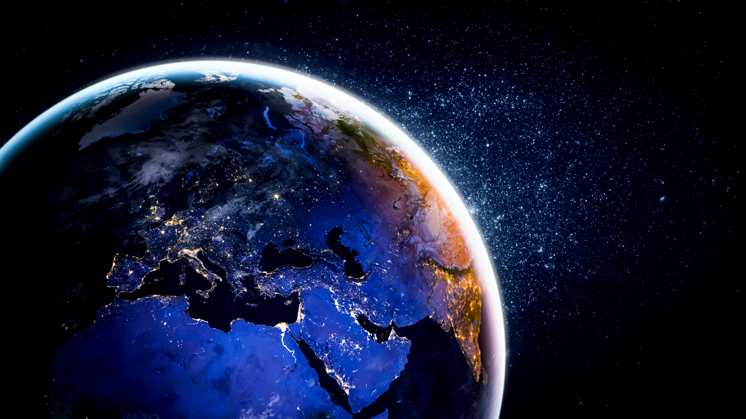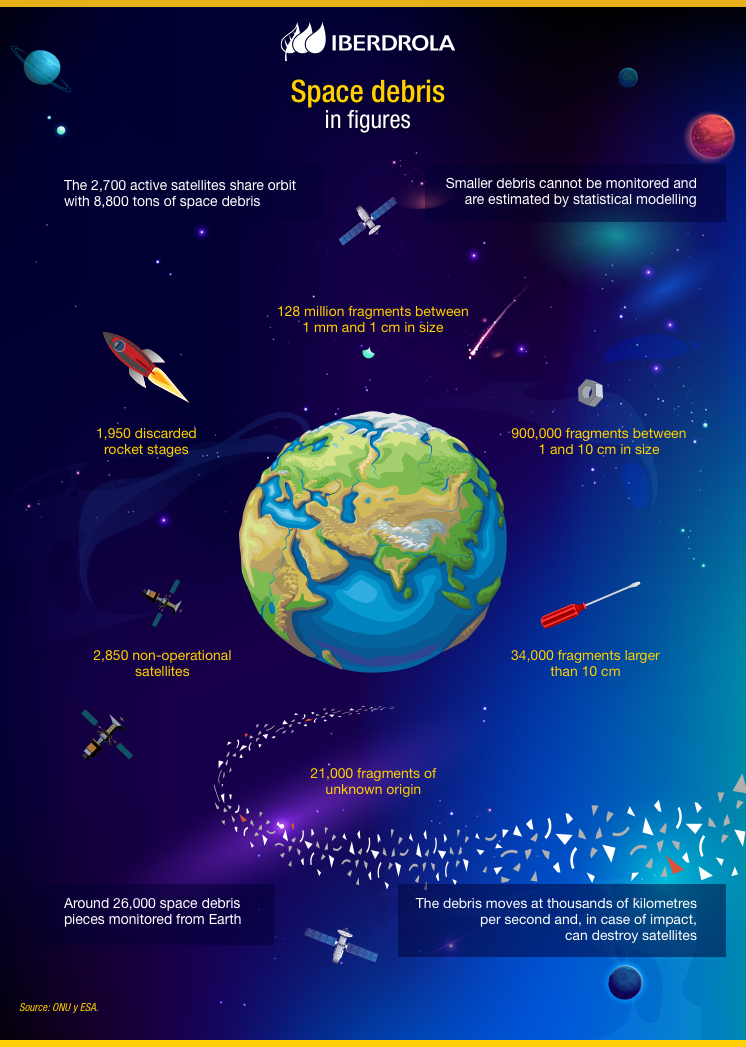Space debris
Space debris: is it time to start taking care of the cosmos?
Since the beginning of the space era in 1957, tons of rockets, space ships and satellites have been launched into space and, at least initially, no one foresaw what to do with them at the end of their useful life. The European Space Agency (ESA) estimates that there are some 900,000 objects over one centimetre in size that have no use orbiting the Earth. This fact, according to the UN, endangers future missions and even terrestrial communications.

Since humans began to explore space, they have also begun to litter it. In our planet's orbit are hundreds of inactive satellites and thousands of fragments from the rockets that have been launched in our short but frenetic space race, as well as debris from collisions. This situation is a real danger today, both for terrestrial telecommunications and for ongoing missions.
What is space debris
Space waste encompasses any piece of debris left behind by humans in space and therefore originating on Earth. Space debris can be as large as an inactive satellite, similar to the size of a car, or as small as a flake of paint. The real danger is the speed at which these objects move, more than 28,000 kilometres per hour, which turns them into real projectiles.
At the dawn of the space age in 1957, the North American Aerospace Defense Command (NORAD) started a database with information about all this waste. The first piece of space junk was the Sputnik satellite, which the Soviet Union launched that same year. These days, the European Space Agency (ESA), says there are around 900,000 objects measuring between 1 and 10 cm in orbit and around 34,000 larger than 10 cm. Many are visible on this interactive map External link, opens in new window..
External link, opens in new window..
The United Nations Office for Outer Space Affairs (UNOOSA) has been drawing attention to the dangers of space waste External link, opens in new window. and the need for prevention for many years, to the extent that back in 2007 the UN General Assembly approved a set of guidelines to mitigate the threat. For its part, the ESA also has an information programme
External link, opens in new window. and the need for prevention for many years, to the extent that back in 2007 the UN General Assembly approved a set of guidelines to mitigate the threat. For its part, the ESA also has an information programme External link, opens in new window. on the risks of space debris.
External link, opens in new window. on the risks of space debris.
Types of space debris
According to the ESA, space debris include:
- Payload: these are mainly satellites. This includes fragments produced by wear and tear and collisions.
- Rockets: remains of stages used to propel missions in orbit. This also includes fragments produced by wear and tear and collisions.
- Mission-related objects: for example, dropped tools, screws, cables, cameras, etc.
Space waste is classified by size as follows:
- Below 1 cm: it is estimated that there are more than 128 million of these fragments and most of them are undetectable.
- Between 1 and 10 cm: it is calculated that there are around 900,000 in orbit, which range from the size of a marble to a tennis ball.
- More than 10 cm: these objects include everything from tools lost during missions to defunct satellites.

SEE INFOGRAPHIC: Space debris in figures [PDF] External link, opens in new window.
Causes of space debris
What causes space waste? There are numerous causes:
 Defunct satellites
Defunct satellites
Satellites have a limited useful life and, when their batteries are spent or they break down, they are left drifting about in space. At the beginning of the space race, it was assumed that sooner or later these abandoned objects would fall to earth and would burn up on re-entry. However, and particularly at higher orbits, this may never happen.
 Missing equipment
Missing equipment
Astronauts sometimes drop tools or other objects during space walks. In 2008, for example, astronaut Heidemarie Stefanyshyn-Piper dropped a box of tools. This disintegrated when it entered the Earth's atmosphere almost a year later, after orbiting the Earth more than 4,000 times.
 Rocket stages
Rocket stages
Some rocket stages are discarded in low orbits and fall to Earth shortly after takeoff. However, the higher ones are left drifting in space and sometimes explode because they contain the remains of fuel. These explosions create thousands of fragments.
 Weapons
Weapons
Both the United States and the Soviet Union began to conduct tests with anti-satellite weapons in the sixties and seventies. In 1985, for example, the United States destroyed a one-ton satellite (Solwind) with one of these weapons. Similar missions of this type were carried out in later years by other countries including China and India.
Consequences of space debris
According to the ESA, since 1961 there have been more than 560 fragmentation incidents, most of them caused by fuel explosions in rocket stages. As for direct collisions, there have only been seven, the most serious of which destroyed an inactive Russian satellite called Kosmos 2251 and the operational satellite Iridium 33.
However, it is the small fragments that pose the greatest danger. Micrometeorites like paint flakes and solidified droplets of antifreeze can damage solar panels on active satellites. Other dangerous debris includes vestiges of solid fuel which float about in space and are highly flammable. They can cause damage and disperse pollutants into the atmosphere if they explode.
Some Russian satellites contain nuclear batteries with radioactive material that could cause dangerous contamination if they returned to Earth. In any case, the heat of reentry destroys the majority of this space debris before it reaches the Earth. On rare occasions, larger fragments have reached the surface and caused considerable damage.
Solutions to space debris
The main challenge is not to produce more space waste, particularly since swarms of small satellites are now circulating at low orbits to give high-speed internet access all over the planet. When it comes to the debris already in orbit, many satellites, as well as the International Space Station, are equipped with Whipple Shields, an outer shell that protects the walls of the object from a possible collision. Here are some of the other strategies used to avoid this problem:
- Orbit changes: many modern satellites are launched into elliptical orbits with perigees within the Earth's atmosphere, which causes them to break up eventually.
- Self-destruction: consists of programming the satellite to leave its orbit at the end of its useful life and be eliminated when it comes into contact with the atmosphere.
- Passivisation: is the removal of any internal energy contained in the vehicle at the end of its useful life. Although the chassis remains in orbit, there is less risk of explosions. The same applies to the rocket stages.
- Reuse: these rockets return to Earth intact. These are used by Space X, the aerospace company owned by Elon Musk.
- Laser: consisting of stopping the fragments by vaporising their surface with a powerful laser, which stops them and causes them to fall.




